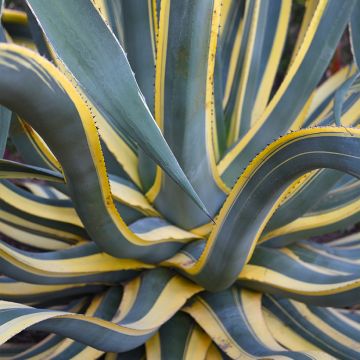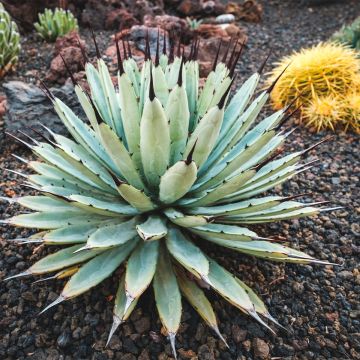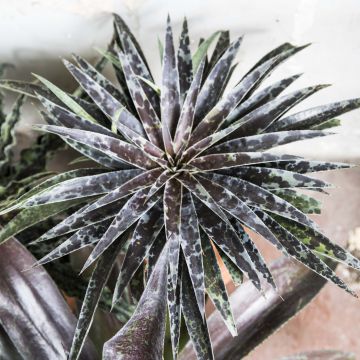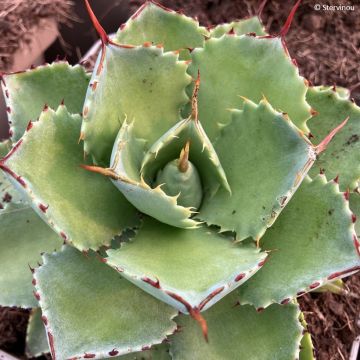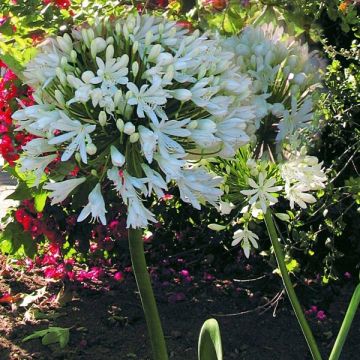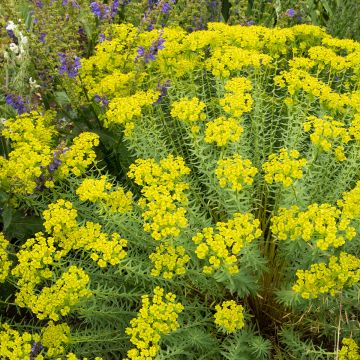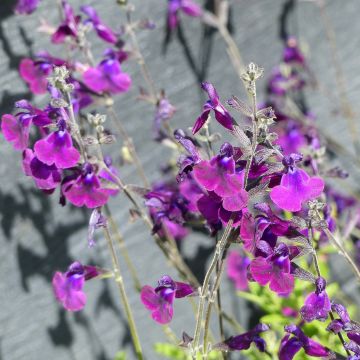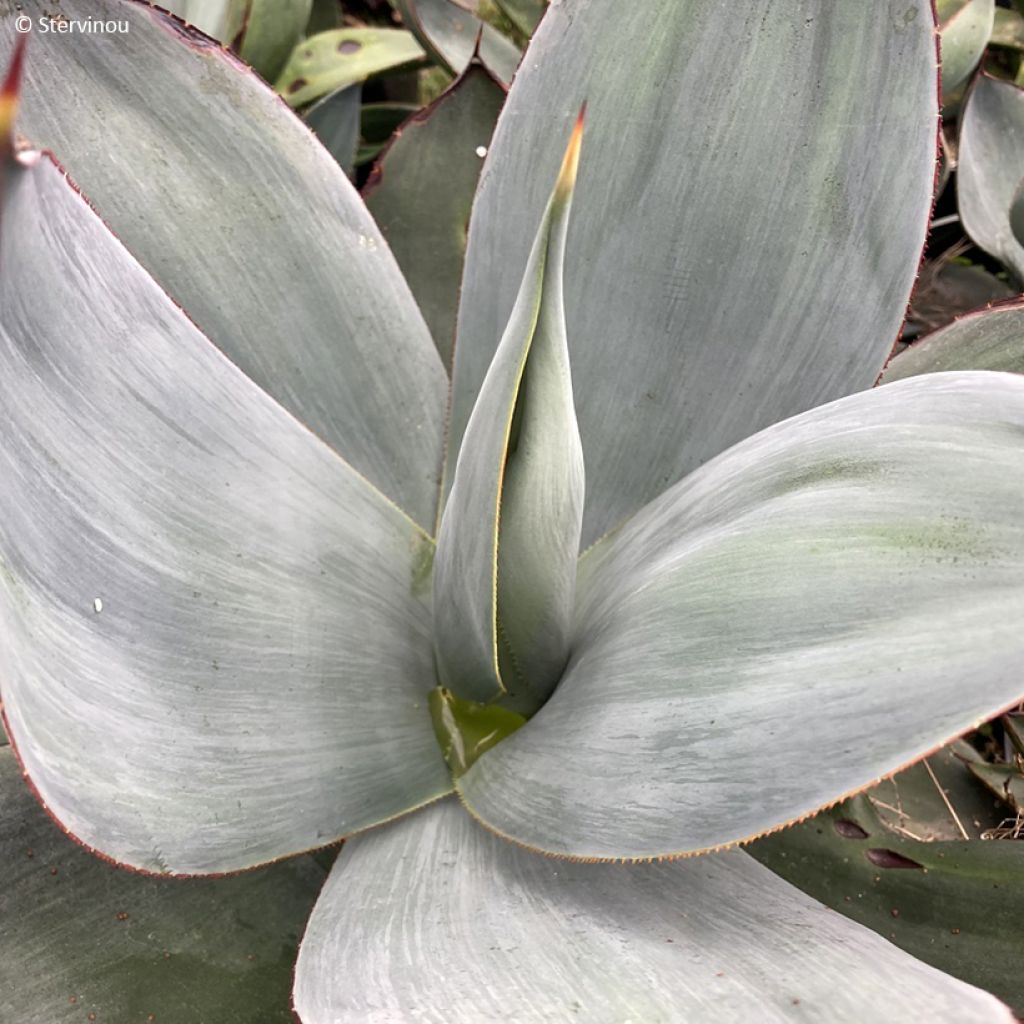

Agave celsii Nova - Agave mitis
Agave celsii Nova - Agave mitis
Agave celsii Nova
This item cannot be shipped to the selected country
Delivery charge from €5.90
More information
Schedule delivery date,
and select date in basket
This plant carries a 12 months recovery warranty
More information
We guarantee the quality of our plants for a full growing cycle, and will replace at our expense any plant that fails to recover under normal climatic and planting conditions.
From €5.90 for pickup delivery and €6.90 for home delivery
Express home delivery from €8.90.
Does this plant fit my garden?
Set up your Plantfit profile →
Description
The Agave celsii 'Nova' is a hybrid with a small mystery surrounding its parentage, yet its aesthetics win everyone over. Of relatively rapid growth, the plant forms a magnificent rosette of wide leaves with a superb grey-blue colour, enhanced by a line of small, non-dangerous red thorns running along the leaf blade. Very graceful, the rosette with perfect geometric shapes evokes, with its graceful form, a lotus flower. Compact, this Agave, which will not exceed 50 to 60 cm, can easily be grown in a pot to be overwintered in sheltered climates too cold for it. In exchange for its rapid growth, its lifespan is shorter than other varieties, but ends beautifully with a very ornamental flowering.
The Agave, once a flagship genus of the Agavaceae family, now belongs to the Asparagaceae family, which now includes several former botanical families, and takes its name from asparagus (Asparagus in Latin). This expanded family hosts many ornamental genera quite different in appearance from each other, such as the Scilla, a charming bulb with modest-sized flowers, or the much larger and imposing Yucca. The Agave genus includes a large number of species, from 190 to several hundred according to authors, originating from the southern United States, Mexico, Central and South America. Many of them are used for ornamental purposes and some even have a culinary interest (agave syrup, tequila, mescal...).
The Agave celsii 'Nova' is a hybrid with uncertain parentage, likely involving Agave mitis, a species native to the Mexican states of Hidalgo, San Luis Potosi, and Tamaulipas (north of Mexico). The second parent could be, according to sources, Agave potatorum, or Agave montana, or perhaps another? Nevertheless, this natural hybrid was brought to market by a Californian nursery and proves to be particularly ornamental. It stands out for its relatively fast growth (for an Agave...) which allows it to quickly form a beautiful, well-structured rosette, as we like with these types of plants. This rosette gradually grows to a height of 50 to a maximum of 60 cm and a diameter of 60 to 70 cm in adult specimens. It is made up of gracefully incurved leaves that give the plant a slight resemblance to a lotus flower or a double tulip. The leaves reach their maximum width at about mid-length and display a beautiful, aesthetically pleasing grey-blue hue. They are adorned with small dark red teeth around their entire perimeter, which leave their mark on the adjacent leaf surface, as they are tightly pressed against each other at the heart of the rosette before opening. These dark thorns elegantly emphasize the leaf's morphology without being truly dangerous, but the terminal point of the leaf of the same colour is indeed dangerous to hands and eyes. As a result of its faster growth than other varieties, this Agave also flowers more quickly (after a few years nonetheless...). It then forms a massive flower spike, significantly taller than its own height, which blossoms into hundreds of yellow flowers emerging from light green buds, creating a spectacle as superb as it is impressive. Alas, this generally marks the plant's demise, as it rarely produces offshoots from the stump, unlike many other species.
The Agave celsii 'Nova' is a hybrid of great interest in more ways than one, deserving its place in the garden despite its shorter lifespan compared to many of its counterparts. Its rapid growth is a real asset to enjoy its beauty within a reasonable timeframe, while its compactness allows it to be easily grown in pots in cold climates. In Mediterranean regions, it will easily find its place even in small gardens, where temperatures do not drop below -5° to -7°C. By associating it with other plants from dry areas, such as the Prickly Pear Cactus (Opuntia) with their distinctive silhouettes evoking desert zones, you will create very evocative beds, while the beauty of their flowering is as attractive as it is fleeting. The "Red Yucca" (Hesperaloe parviflora) will also be a perfect companion, with its extremely slender leaves forming a dark tuft from which coral-red flower spikes emerge in summer, absolutely irresistible. A carpet of Delosperma, a small succulent perennial, whose flowers come in many bright colours depending on the variety, will complete your scene...
Report an error about the product description
Flowering
Foliage
Plant habit
Botanical data
Agave
celsii
Nova
Asparagaceae
Agave mitis x potatorum Nova
Central America
Other Agave
Planting and care
Plant L'Agave celsii 'Nova' preferably in full sun, in the south, it tolerates partial shade part of the day. Plant it in a preferably poor soil, even rocky, limestone, sandy, and especially very well-drained. It tolerates winter humidity and cold poorly, but much better dry cold, in a dry soil. It is best to protect this plant from humidity in regions with rainy winters, through a temporary waterproof shelter, but allowing light to pass through, such as a transparent plastic tarp. If this setup is not aesthetically pleasing, it has the merit of saving the life of this rare plant. In very cold climates, however, it will need to be grown in a pot to overwinter it indoors. As it tolerates perfectly dry, even arid soils in summer, one can for example dig a 50 cm pit, fill it with a mixture of rocks and light soil and plant the Agave, isolating its collar from stagnant water. The drier the soil, the more it will resist frost, down to about -7°C.
This Agave has a rather modest growth, it can be easily grown in a pot on the terrace or balcony, in a light substrate such as cactus soil, with careful drainage, preferably in terracotta. Water regularly in summer, but let the substrate dry between waterings. It will then be easy to store the pot away from heavy frosts and humidity, in a bright, airy, minimally heated room. Reduce or even stop watering in winter. The plant can spend the warm season, from April to October, outdoors.
The side thorns of the leaves are less dangerous than in some other species, but beware of the terminal point!
Planting period
Intended location
Care
This item has not been reviewed yet - be the first to leave a review about it.
Mediterranean perennials
Haven't found what you were looking for?
Hardiness is the lowest winter temperature a plant can endure without suffering serious damage or even dying. However, hardiness is affected by location (a sheltered area, such as a patio), protection (winter cover) and soil type (hardiness is improved by well-drained soil).

Photo Sharing Terms & Conditions
In order to encourage gardeners to interact and share their experiences, Promesse de fleurs offers various media enabling content to be uploaded onto its Site - in particular via the ‘Photo sharing’ module.
The User agrees to refrain from:
- Posting any content that is illegal, prejudicial, insulting, racist, inciteful to hatred, revisionist, contrary to public decency, that infringes on privacy or on the privacy rights of third parties, in particular the publicity rights of persons and goods, intellectual property rights, or the right to privacy.
- Submitting content on behalf of a third party;
- Impersonate the identity of a third party and/or publish any personal information about a third party;
In general, the User undertakes to refrain from any unethical behaviour.
All Content (in particular text, comments, files, images, photos, videos, creative works, etc.), which may be subject to property or intellectual property rights, image or other private rights, shall remain the property of the User, subject to the limited rights granted by the terms of the licence granted by Promesse de fleurs as stated below. Users are at liberty to publish or not to publish such Content on the Site, notably via the ‘Photo Sharing’ facility, and accept that this Content shall be made public and freely accessible, notably on the Internet.
Users further acknowledge, undertake to have ,and guarantee that they hold all necessary rights and permissions to publish such material on the Site, in particular with regard to the legislation in force pertaining to any privacy, property, intellectual property, image, or contractual rights, or rights of any other nature. By publishing such Content on the Site, Users acknowledge accepting full liability as publishers of the Content within the meaning of the law, and grant Promesse de fleurs, free of charge, an inclusive, worldwide licence for the said Content for the entire duration of its publication, including all reproduction, representation, up/downloading, displaying, performing, transmission, and storage rights.
Users also grant permission for their name to be linked to the Content and accept that this link may not always be made available.
By engaging in posting material, Users consent to their Content becoming automatically accessible on the Internet, in particular on other sites and/or blogs and/or web pages of the Promesse de fleurs site, including in particular social pages and the Promesse de fleurs catalogue.
Users may secure the removal of entrusted content free of charge by issuing a simple request via our contact form.
The flowering period indicated on our website applies to countries and regions located in USDA zone 8 (France, the United Kingdom, Ireland, the Netherlands, etc.)
It will vary according to where you live:
- In zones 9 to 10 (Italy, Spain, Greece, etc.), flowering will occur about 2 to 4 weeks earlier.
- In zones 6 to 7 (Germany, Poland, Slovenia, and lower mountainous regions), flowering will be delayed by 2 to 3 weeks.
- In zone 5 (Central Europe, Scandinavia), blooming will be delayed by 3 to 5 weeks.
In temperate climates, pruning of spring-flowering shrubs (forsythia, spireas, etc.) should be done just after flowering.
Pruning of summer-flowering shrubs (Indian Lilac, Perovskia, etc.) can be done in winter or spring.
In cold regions as well as with frost-sensitive plants, avoid pruning too early when severe frosts may still occur.
The planting period indicated on our website applies to countries and regions located in USDA zone 8 (France, United Kingdom, Ireland, Netherlands).
It will vary according to where you live:
- In Mediterranean zones (Marseille, Madrid, Milan, etc.), autumn and winter are the best planting periods.
- In continental zones (Strasbourg, Munich, Vienna, etc.), delay planting by 2 to 3 weeks in spring and bring it forward by 2 to 4 weeks in autumn.
- In mountainous regions (the Alps, Pyrenees, Carpathians, etc.), it is best to plant in late spring (May-June) or late summer (August-September).
The harvesting period indicated on our website applies to countries and regions in USDA zone 8 (France, England, Ireland, the Netherlands).
In colder areas (Scandinavia, Poland, Austria...) fruit and vegetable harvests are likely to be delayed by 3-4 weeks.
In warmer areas (Italy, Spain, Greece, etc.), harvesting will probably take place earlier, depending on weather conditions.
The sowing periods indicated on our website apply to countries and regions within USDA Zone 8 (France, UK, Ireland, Netherlands).
In colder areas (Scandinavia, Poland, Austria...), delay any outdoor sowing by 3-4 weeks, or sow under glass.
In warmer climes (Italy, Spain, Greece, etc.), bring outdoor sowing forward by a few weeks.

































